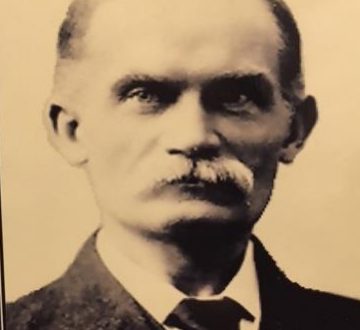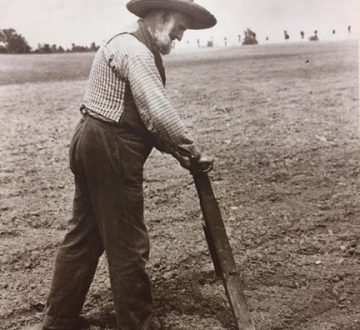NOTE: This story comes with an accompanying podcast — scroll to the bottom of the page to listen!
The Canadian Seed Growers’ Association (CSGA) is the oldest seed sector group in Canada, and remains the largest.
The beginning of the 20th century was a profound time for Canadian seed. The industry was in its infancy, and waves of farmers flocking to Canada from overseas were in for a rude awakening.
“That was a hard time for growers. They were faced with using seed varieties they brought over from Europe, and what they got were lot of agronomic problems. These varieties were just not performing under Canadian growing conditions,” says Randy Preater, special adviser to the Canadian Seed Growers’ Association (CSGA) and a former program manager for the organization.
The Canadian Seed Growers’ Association (CSGA) was formed in 1904 to represent seed growers around the country. Interestingly, it was the resourcefulness of farm kids that made it all possible.
According to the CSGA, in 1899, J.W. Robertson, the Commissioner of Agriculture and Dairying in the Dominion Department of Agriculture, conceived a plan to encourage farm children to grow better crops from better seed. He donated $100 for prizes to junior farmers to collect the best 100 heads of wheat and barley on their families’ farms. The following year, Sir William C. Macdonald of Montreal donated $10,000 to continue the program and develop a larger seed plot competition amongst farm children.
The competition lasted three years and developed a strong following, including the parents of the children involved. After the completion of the competition, the parents of those children expressed a desire to continue the work of selecting better seed.
As a result, the CSGA was established in 1904 and those parents would eventually become the first original members of the association.
“There was an understanding that we needed to carefully preserve the genetic identity of these varieties, and make sure they were adapted to perform reliably in areas around the country,” Preater says.
In 1924, CSGA named its first farmer president. Up until then, a government appointee had run the organization. Notwithstanding its name, it was essentially an agency of government that was transitioned to industry leadership upon the arrival of the 1920s.
Glyn Chancey, executive director of CSGA — who prior to joining CSGA in 2015 spent 30 years in federal public service — notes both SeCan and the Canadian Seed Institute (CSI) were initially run as adjuncts of the CSGA. SeCan became the largest Canadian supplier of certified seed, especially with varieties from public sector breeders, with 700 independent business members. CSI became the auditor recognized by the Canadian Food Inspection Agency (CFIA) for all CFIA-licensed seed conditioners, importers and testing labs.

“Since the beginning in 1904, CSGA was the vehicle that the government of the day felt was most appropriate for moving responsibility for the seed regulatory system to the industry. To this day, that’s really what CSGA is about. It’s the manifestation of the industry’s ever-increasing role in self-regulating.”
One of CSGA’s numerous objectives remains to ensure and certify the varietal purity of seed produced by its members, but the organization has had to weather the storms of a constantly changing seed landscape, both in terms of technology and regulation.
The CSGA has been an inspiration of sorts to the Canadian seed sector. Since its founding, five other organizations have sprung up to represent the industry: the Canadian Seed Trade Association (CSTA) was founded in 1923; the Commercial Seed Analysts Association of Canada (CSAAC) came along in 1944; CropLife Canada was formed in 1952; and the Canadian Seed Institute (CSI) was founded in 1997, along with the Canadian Plant Technology Agency (CPTA) that same year.
“When you look at our organization’s history, you have to make a distinction between the last 30 years and the last 100 years. When I started my career in government 30 years ago, the seed program was part of the inspection branch of Agriculture and Agri-Food Canada (AAFC). There was a shift that took place where government decided it was going to rethink its role and give more room for the market to operate as it became more open,” Chancey says.
“We basically shifted the policy foundation for how we supported and interacted with the ag sector. The only problem was we didn’t update our vision for how the seed regulatory system was going to evolve. I think CSGA has done a great job with limited resources to try and sustain a system that has long needed a new vision and new investment, and possibly new institutions.”

Today, the CSGA enjoys a membership of 3,500 made up of individual seed growers and small to large-size businesses. You have to grow at minimum one field of certified seed in order to become a member of CSGA.
CSGA’s functions have evolved to deal with other challenges that aren’t simply agronomic, Preater notes. CSGA has evolved and has seven provincial associations — British Columbia, Alberta, Saskatchewan, Manitoba, Ontario, Quebec, and the Maritimes.
“Over that 113 years since CSGA was formed, because it was a very representative organization, its provincial associations have helped reflect regional concerns. It has also supported a competitive seed production sector that reflects the nature of this diverse country and supports the small business sector,” Preater says.
“In the last 20 years, as governments reduced their contributions to the ag sector, the private sector increased its investment in seed. When these variety developers and distributors faced technical challenges with certification requirements, which threatened taking production to another country, the CSGA developed alternatives that maintained equivalence with international standards and kept the production here with Canadian seed growers. The role that CSGA has traditionally played in maintaining very high technical standards for varietal purity while providing uniquely Canadian technical solutions for certification challenges may be more important today than in the past, especially with the impact of globalization.”
The arrival of alternative service delivery (ASD) was a major opportunity for the CSGA to show its ability to adapt to changing times. Doug Miller, managing director of certification and technology services, led a project to automate CSGA’s certification system in response to ASD. Under Miller’s watch, CSGA transformed its entire business process to a paperless, electronic platform using Laserfiche and LincDoc software.
The wildly successful initiative was recognized with a LaserFiche Run Smarter Award for the most visionary Laserfiche initiative, an international honour awarded to organizations that use LaserFiche software.
In 2016, CSGA recruited former CFIA national seed program manager Mike Scheffel to be CSGA’s policy director. He brings an in-depth understanding of the seed regulatory landscape both domestically and internationally, and detailed knowledge of the other five associations that represent the Canadian seed industry.
In response to the shifting seed scene, CSGA began to undertake a strategic plan exercise in 2016. The new five-year strategic plan will be presented at its July 2017 annual general meeting in Halifax, N.S., after which the focus shifts to its implementation.
The concertmaster for CSGA’s strategic planning process is the veteran consultant Monty Doyle, a recognized expert in facilitating and managing these types of exercises.
According to Doyle, if the plan is implemented, not only will the CSGA and its members be better off, but so will the whole sector — the strategic plan was crafted with a view of modernizing the certification system while building stronger sector partnerships, with CSGA stepping up and being a stronger advocate for its members in the process.
“It’s a very ambitious plan,” Chancey says.
—The Past, Present, Future series examines each of our sector’s six representative groups over the next several months to offer insight into why they were founded, what they do, and the role they expect to play in the future. For previous instalments, go here.













